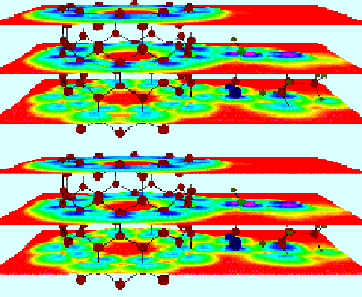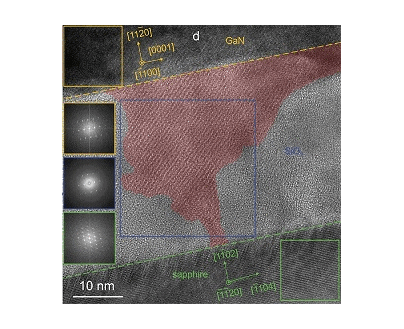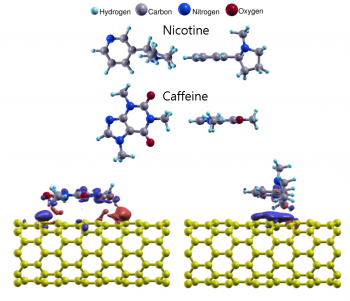User Tools
Sidebar
Table of Contents
Research Highlights in Computational NanoPhysics Lab
This page is under construction
We are investigating various properties of diverse materials including semconductors, metals, and nanostructured materials, and their potential applications, using theoretical and computational methods.
Following are brief summaries of research projects conducted by Computational NanoPhysics Lab.
Phase Change Materials
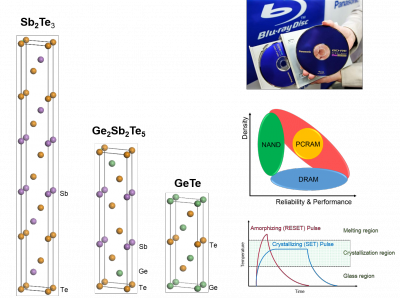 A phase change material is a material
exhibiting easy and fast transition between crystalline
and amorphous phases. Due to this
characteristic, phase change materials have been used for rewritable
DVDs and Blueray disks, and are expected to be used for phase change
random access memory. Ge-Sb-Te compounds are major phase change
materials. We are performing molecular dynamics simulations to
identify amorphous phases of various Ge-Sb-Te compounds. Our
simulation data are analyzed to explore local atomic structures of
amorphous phases, which are compared with those of their crystalline
counterparts.
A phase change material is a material
exhibiting easy and fast transition between crystalline
and amorphous phases. Due to this
characteristic, phase change materials have been used for rewritable
DVDs and Blueray disks, and are expected to be used for phase change
random access memory. Ge-Sb-Te compounds are major phase change
materials. We are performing molecular dynamics simulations to
identify amorphous phases of various Ge-Sb-Te compounds. Our
simulation data are analyzed to explore local atomic structures of
amorphous phases, which are compared with those of their crystalline
counterparts.
GeTe
We investigate structural properties of varius amorphous phases and crystalline using molecular dynamics simulation. Also, based on a Radial Distribution Functions(RDFs), Angle Distribution Functions(ADFs) and Order Parameters(OPs) analyses, we study local structure characteristics of several phases. Our calculated OPs and RDFs are analyzed and compared to EXAFS data available. Finally, we estimate energy barriers not only between crystalline and one of amorphous phases, but also between different amorphous phases to explore their structural stability, using nudged elastic band method.
GeSbTe225
The phase transition of Ge2Sb2Te5 between its crystalline and amorphous phases was investigated by constructing its various amorphous phases.
Sb$_2$Te$_3$
Sb$_2$Te$_3$ is a very interesting material for rewritable optical media. We study of the switching mechanism between the amorphous and crystal states theoretically.
Phosphorene & Phosphorene Oxides
Phosphorene is a single layer of black phosphorous, recently synthesized. Its two-dimentional structure is similar to the carbon-based graphene, however, it is semiconductor compared to graphene with zero gap. So this material has attracted much attention due to its potential usage for electronic or optoelectronic devices. Because of a lone pair of electrons on each phosphorous atom, however, pristine phosphorene may be extremely reactive with air, especially with oxygen, and thus the oxidation of phosphorene would be unavoidable during synthesis and/or fabrication processes unless they were done in a vacuum environment.
Structural properties of phosphorene oxides
Due to the existence of a lone pair of electrons on each P atom, phosphorene can be easily oxidized. At first, we have investigated the structural stability of POx with 0<x<1. For every given 0<x<1 of POx, diverse configurations are considered and optimized to find its equilibrium structure to know whether such a phosphorene oxide can be formed or not.
Strain effects on electronic properties of phosphorene oxides
As x increases in POx, the electronic properties of phosphorene oxides changes. We found an intriguing phenomenon that at around 16% uniaxial tensile strain, PO (with x=1) becomes a metal with a modified Dirac cone at the gamma point in its Brillouin zone.
Transition Metal Dichalcogenides (MX$_2$)
Transition metal dichalcogneides (MX$_2$) are another 2D layered materials similar to graphene. We investigate the physical properties of various MX, where M is a transition metal atom in group 4 (Ti, Zr, Hf), 5 (V, Nb, Ta), or 6 (Cr, Mo, W) elements; and X is a chalcogen atom, either S or Se.
Single-layer MX$_2$
We investigate the structural, electronic properties of MX. (M=Ti, V, Cr, Zr, Nb, Mo, Hf, Ta, W) (X=S, Se) and their phase transition. We calculate the relative stability of two phase structures (octahedral-T and trigonal-H) determined by considering relative positions of X. We find interesting phase existence for the each group in the periodic table. The stable phase structure of IV-group (Ti, Zr, Hf) is octahedral, while VI-group (Cr, Mo, W) is trigonal, and V-group (V, Nb, Ta) is possible two phase structures. Two phase structures of MX have a same total energy at the same lattice constant near the each most stable lattice constant. From these results, we also study activation energy barriers at the various lattice constants such as from stable T phase to H phase, same total energy, and from stable H to T. Interestingly we find that the activation energy barrier is small at the small and large lattice constants for the stable lattice constants. It means that the phase transition occurs by compressive and tensile strains.
Stacking Configurations of MX$_2$
We investigate the effect of the interlayer interaction on the structural and electronic properties of layered MX2(M=Ti, Zr, Hf, Cr, Mo, W) structures with van der Waals interaction. We calculate the relative stability of various layer-layer stacking configurations determined by considering relative positions and orientations between neighboring layers. It is found that an intriguing coupling effect between stacking and electronic structure. Some stacking configuration with a lager inter-layer distance exhibit larger electronic band gap than the other structures.
Graphyne
Graphyne is a cousion of graphene with sp-hybridized acetylenic linkage connecting sp2 bonding in graphene.
Thermal expansion of graphyne
We have investigated the thermal expansion behaviors of three different types (α, β, and γ) of graphyne which is a two-dimensional carbon allotrope composed of sp and sp2 bonds. We have found that all three types of graphyne exhibit negative in-plane thermal expansion. The observed in-plane thermal contraction can be attributed to the ripple effect, similarly in graphene. However, the ripple effect itself is not sufficient to explain anomalously larger thermal contraction found in graphyne than in graphene. Our deliberate analysis on the phonon modes observed in graphyne enables us to discover another source causing such amplified contraction behavior. We found that there are particular phonon modes with frequencies around a few hundreds of cm-1 existing exclusively in graphyne that may fill empty spaces resulting in area reduction. These modes are attributed to the libration of “rigid units” composed of triple bonds
- Rigid unit modes in sp-sp2 hybridized carbon systems: Origin of negative thermal expansion
Cheol-Woon Kim, Seoung-Hun Kang, and Young-Kyun Kwon, Phys. Rev. B 92 (24), 245434 (2015).
link: download:
download: 

 arXiv:1507.05562
arXiv:1507.05562
Strain-induced metal-insulator transition in graphyne
We have found a strain-induced metal-insulator transition in graphyne blah blah
III-V Materials
A Compound semiconductor is a semiconductor compound composed of elements from two or more different groups of the periodic table. blah blah
Thru-hole epitaxy
Thru-hole epitaxy has recently been reported to be able to grow readily detachable domains crystallographically aligned with the underlying substrate over 2D mask material transferred onto a substrate. [Jang \textit{et al.}, \textit{Adv. Mater. Interfaces}, \textbf{2023} \textit{10}, 4 2201406] While the experimental demonstration of thru-hole epitaxy of GaN over multiple stacks of h-BN was evident, the detailed mechanism of how small holes in each stack of h-BN survived as thru-holes during multiple stacking of h-BN was not intuitively clear. Here, we use Monte Carlo simulations to investigate the conditions under which holes in each stack of 2D mask layers can survive as thru-holes during multiple stacking. If holes are highly anisotropic in shape by connecting smaller holes in a particular direction, thru-holes can be maintained with a high survival rate per stack, establishing more epitaxial connectedness. Our work verifies and supports that thru-hole epitaxy is attributed to the epitaxial connectedness established by thru-holes surviving even through multiple stacks.
Controllable growth and facile transferability of a crystalline film with desired characteristics, acquired by tuning composition and crystallographic orientation, become highly demanded for advanced flexible devices. Here the desired crystallographic orientations and facile transferability of a crystalline film can be achieved by “thru-hole epitaxy” in a straightforward and undemanding manner with no limitation on the layer number and polarity of a 2D space layer and the surface characteristics. The crystallographic alignment can be established by the connectedness of the grown material to the substrate through a small net cross-sectional area of thru-holes, which also allows the straightforward detachment of the grown material. Thru-hole epitaxy can be adopted for the realization of advanced flexible devices on large scale with desired crystallographic orientation and facile transferability.
- Thru-hole Epitaxy: A Highway for Controllable and Transferable Epitaxial Growth
Dongsoo Jang, Chulwoo Ahn, Youngjun Lee, Seungjun Lee, Hyunkyu Lee, Donghoi Kim, Yongsun Kim, Ji-Yong Park, Young-Kyun Kwon, Jaewu Choi, and Chinkyo Kim, Adv. Mater. Interfaces, 10 (4), 2201406 (2023).
link:
 download:
download: 


Optical properties of GaAsSb
It is very important to understand the electronic structure of GaAs and GaSb for fabrication of electronic and optoelectronic devices. Recently, tenary compounds, GaAs1-xSbx began to attract much attention from researchers because they were synthesized and expected to be new materials for optoeletronic devices. For x = 1 and x = 0, there have been a lot of computational studies to investigate their structural, electronic and optical properties, but few studies for general cases. Moreover, it has been known that “regular” density functional calculations does not describe the correct electronic structures including underestimated band gap and incorrect band splitting. To resolve such issues, we consider spin-orbit coupling effects and GW corrections on GaAs1-xSbx with the composition of x = 0, 0.25, 0.5, 0.75, and 1. To calculate their band structures, we make use of maximally localized Wannier functions to interpolate GW quasiparticle band structures. Based on our GW calculations, we discuss the trend of band gaps at various high symmetric points in the Brillouin zone with the composition x.
Latent Order in High-Angle Grain Boundary of GaN
We report the existence of latent order during core relaxation in the high-angle grain boundaries (GBs) of GaN films using atomic-resolution scanning transmission electron microscopy and ab initio density functional theory calculations. Core structures in the high-angle GBs are characterized by two pairs of Ga-N bonds located next to each other. The core type correlates strongly with the bond angle differences. We identify an order of core relaxation hidden in the high-angle GBs by further classifying the 5/7 atom cores into a stable 5/7 core (5/7(S)) and a metastable 5/7 core (5/7(M)). This core-type classification indicates that metastable cores can exist at real high-angle GBs under certain circumstances. Interestingly, 5/7(M) exhibits distinct defect states compared to 5/7(S), despite their similar atomic configurations. We investigate the reconstruction of defect states observed in 5/7(M) by analyzing the real-space wave functions. An inversion occurred between two localized states during the transition from 5/7(S) to 5/7(M). We suggest an inversion mechanism to explain the formation of new defect states in 5/7(M).
- Latent Order in High-Angle Grain Boundary of GaN
Sangmoon Yoon, Hyobin Yoo, Seoung-Hun Kang, Miyoung Kim, and Young-Kyun Kwon, Sci. Rep. 8, 4647 (2018).
link:
 download:
download: 


Morphology transformation of faceted GaN microcrystals
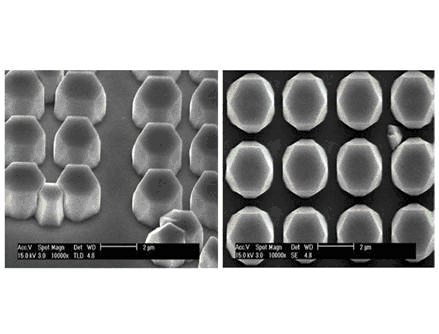
We have studied the growth and characterization of patterned and
uniformly distributed GaN microcrystals with well-defined facets and
epitaxy. The microcrystals were grown on a mask pattertned by
lithography, and formed by selective-area epitaxy using metal-organic
chemical vapour deposition. The GaN microcrystals have similar sizes
and shapes. Each microcrystal consists of an upper and lower part,
which are rotated by 30 deg. Transmission electron microscopy shows
that there is a rather clear interface between the two parts of the
crystal, suggesting a sudden change in the growth direction. We
performed ab initio calculations for the surface energies of
hexagonal GaN, and the growth morphology is explained based on surface
energy consideration.
- Morphology transformation of patterned, uniform and faceted GaN microcrystals
Tae Woong Kim, Young Joon Hong, Gyu-Chul Yi, Ji-Hwan Kwon, Miyoung Kim, Heung Nam Han, Do Hyun Kim, Kyu Hwan Oh, Ki-Jeong Kong, and Young-Kyun Kwon, J. Phys. D: Appl. Phys. 41 (1), 015406 (2008).
link: download:
download: 

Iron-based Materials
Iron is one of the most important and widely-used materials in our lives. We have studied iron nanoclusters and iron-based alloys using ab initio and parametrized calculations.
Enhanced mechanical properties of Fe-Al alloys with Mn impurity
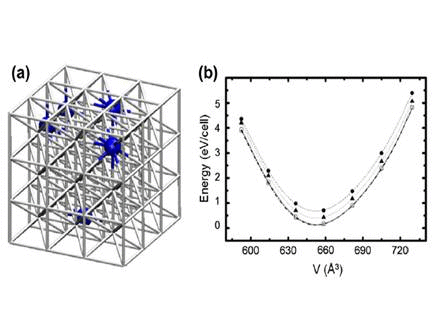
We have examined the structural and mechanical properties of Fe-Al
alloys at various Al concentrations with or without a small amount of
Mn. For each disordered Fe-Al alloy, we considered sundry disordered
configurations to determine the equilibrium structure. It was found
that the disordered Fe-Al alloy with high Al content (~25 at%) becomes
less stable and more brittle than its ordered counterpart
DO3 second phase. To predict the ductility of Fe-Al alloys,
we estimated Pugh's constant defined by the ratio between bulk and
shear moduli and apply the Pugh's criterion. We found that an addition
of a small amount of Mn may stabilize disordered solid solutions over
the DO3 second phase. Moreover, the Mn addition also
improves its mechanical properties making the disordered Fe-Al alloy
more ductile than DO3.
- Enhanced mechanical property of Fe-Al alloy due to Mn insertion: Ab initio study
Seung Jin Kang, Sora Park, Miyoung Kim, Heung Nam Han, Suk-Kyu Lee, Kyoo Young Lee, Young-Kyun Kwon, J. Alloys Compd. 583, 295-299 (2014).
link: download:
download: 

Magic Numbers of Iron Nano Clusters
Using tight-binding method implemented with Stoner model of itinerant magnetism, we have searched the magic numbers of iron nano clusters with up to N=30 iron atoms.
Schwarzites: Carbon Allotrope with Negative Gaussian Curvature
Schwarzite is a carbon allotrope with negative Gaussian curvature.
Structural and electronic properties of schwarzite
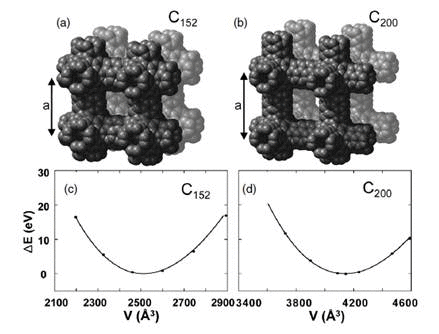
We have studied the stability, elastic properties and electronic
structure of sp2 carbon minimal surfaces with negative
Gaussian curvature, called schwarzites. We focused on two systems with
cubic unit cells containing 152 and 200 carbon atoms, which are
metallic and very rigid. The porous schwarzite structure allows for
efficient and reversible doping by electrondonors and acceptors,
amking it a promising candidate for the next generation of alkali ion
batteries. We identified schwarzite structures that act as arrays of
interconnected spin quantum dots or become magnetic when doped. We
introduced two interpenetrating scwarzite structures that may find
their use as the ultimate super-capacitor.
- Designing rigid carbon foams
Sora Park, Kritsada Kittimanapun, Jeung Sun Ahn, Young-Kyun Kwon, and David Tomanek, J. Phys.: Condens. Matt. 22 (33), 334220 (2010).
link: download:
download: 

Thermoelectric properties of schwarzite
Using ab initio density functional theory and Boltzman transport theory, we have investigated the thermoelectric properties of schwarzite and estimate its ZT values. blah blah.
Metal-Organic Interfaces
We have investigate various phenomena and changes in properties occurring at interfaces between metal and organic molecules using ab initio density functional theory
HATCNT on graphene
Using ab initio density functional theory, we have investigated the structural and electronic properties of self-assembled HATCN patterns on graphene.
HATCN on Au(111) surface
Using ab initio density functional theory, we have investigated the self-assembled pattern of HATCN molecules on gold surface.
DBTP on Ag(111) surface
Using ab initio density functional theory, we have investigated the electronic structures of self-assembled chains comprising Ag atoms and organic molecules.
Gold Nanostructures
We have investigated various properties of divers gold nanostructures using ab initio density functional theory with spin-orbit coupling.
Adsorption properties of golden fullerene
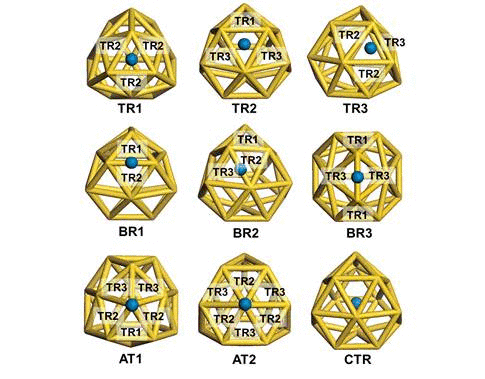
We have investigated the adsorption properties of chalcogen elements
(oxygen and sulfur) and nitrogen on an anionic golden fullerene
Au16- and its effects on the structural and
electronic properties of the golden cage. In particular, we found that
when a sulfur atom is encapsulated inside Au16-,
its bonding character with Au atoms appears ionic due to electron
transfer from sulfur to the gold nanocage. In contrast, the
exohedrally adsorbed S atom tends to have strong orbital hybridization
with the gold nanocage. For an oxygen adsorption case, electrons from
the golden cage tend to be shared with the adsorbed O atom exhibiting
strong orbital hybridization, regardless of its adsorption sites. To
investigate the transition behaviors between the most stable exohedral
and endohedral adsorption configurations, we calculate the activation
and reaction energies in the transition. The oxygen atom experiences a
lower energy barrier than the sulfur atom due to its smaller atomic
radius. Finally, we explore the vibrational properties of S- or
O-adsorbed Au16- 16 buckyballs by calculating
their infrared spectra. When the N atom is adsorbed on the cage,
electrons are transferred to nitrogen from Au 16. The nitrogen atom
may move thermally from the exterior to the interior through a bridge
site. In infrared spectra, exohedral doping causes greater intensities
at higher frequencies than endohedral doping.
- Adsorption properties of chalcogen atoms on a golden buckyball Au16- from first principles
Seoung-Hun Kang, Gunn Kim, and Young-Kyun Kwon, J. Phys.: Condens. Matt. 23 (50), 505301 (2011).
link: download:
download: 

- Binding properties of a nitrogen atom onto an anionic golden fullerene Au16-
Gunn Kim, Seoung-Hun Kang, Chan-young Lim, and Young-Kyun Kwon, Chem. Phys. Lett. 545, 83-87 (2012).
link: download:
download: 

Dimerization of metal-encapsulated gold nanoclusters
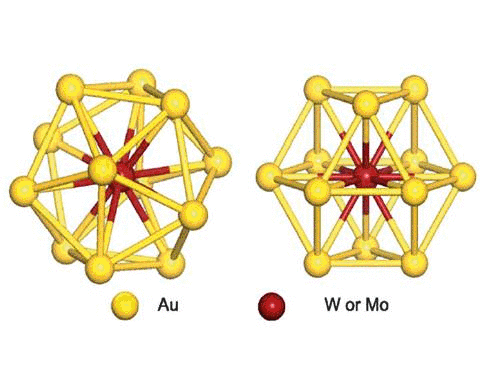
We have studied the dimerization of metal-encapsulated gold
nanoclusters M@Au12 (M = W, Mo) with Ih or
Oh symmetry, and their structural and electronic
properties.To determine the most stable dimer structure in each case,
various configurations are considered. We find that during dimerization,
gold atoms near the interface tend to form inter-cluster triangular bonds,
which stabilize two monomer clusters by about 3.3–3.5 eV.
The dimerization along a specific axis selected as the z axis causes
the symmetry reduction of each M@Au12 cluster resulting in the modification
of electronic structures. It is found that all the stable dimers exhibit
a much smaller HOMO–LUMO gap than those of their comprising monomers.
Such a gap decrease is mainly attributed to the dz2 orbital splitting of the
central atoms owing to dimerization. We also calculate the vibrational modes
and the corresponding IRactive spectra, which are distinguishable
for different dimer configurations. In addition, we find that the
IR-active modes of the Oh-based dimer structures appear to be red-shifted
in comparison to those of Ih-based ones.
Thus, the IR spectra may be utilized experimentally to discriminate dimer
configurations with different central metal atoms and/or dissimilar structural symmetries.
- First-principles investigation on dimerization of metal-encapsulated gold nanoclusters
Sora Park, Gunn Kim, and Young-Kyun Kwon, RSC Adv. 4 (1), 192-198 (2014).
link: download:
download: 

1D chain formation of metal-encapsulated gold nanoclusters
We have studied the 1D chain formation of metal-encapsulated gold nanoclusters M@Au12 (M = W, Mo) with Ih or Oh symmetry, and their structural and electronic properties.
Nanowires
We have investigated various nanowires.
MoSI nanowires
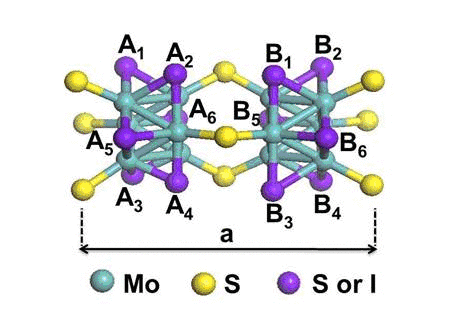 Mo6S9-xIx nanowires exhibit
interesting structural and electronic properties due to the flexible S
linkages, which can be either short or long linke in an accordion. We
have investigated the structrual and electronic properties of isolated
and bundled Mo6S9-xIx
nanowires. We find the optimum interwire distance depends on
composition and to a smaller degree on the orientation of the wires.
Structural order is expected in bundles with x=0 and x=6,
since there is no disorder in the decoration of the Mo clusters.
In bundles with other stoichiometries we expect structural disorder to occur.
We find that the electronic structure of some nanowires can be switched
from metallic to semiconducting by changing the interwire separation.
The most intriguing changes occur in nanowires with x=4.5 and 6,which
change from metal to semiconductor or undergo a magnetic transition
upon axially stretching or compressing the nanowires or upon changing
the inter-wire separation.
Mo6S9-xIx nanowires exhibit
interesting structural and electronic properties due to the flexible S
linkages, which can be either short or long linke in an accordion. We
have investigated the structrual and electronic properties of isolated
and bundled Mo6S9-xIx
nanowires. We find the optimum interwire distance depends on
composition and to a smaller degree on the orientation of the wires.
Structural order is expected in bundles with x=0 and x=6,
since there is no disorder in the decoration of the Mo clusters.
In bundles with other stoichiometries we expect structural disorder to occur.
We find that the electronic structure of some nanowires can be switched
from metallic to semiconducting by changing the interwire separation.
The most intriguing changes occur in nanowires with x=4.5 and 6,which
change from metal to semiconductor or undergo a magnetic transition
upon axially stretching or compressing the nanowires or upon changing
the inter-wire separation.
- Effect of bundling on the stability, equilibrium geometry and electronic structure of Mo6S9-xIx nanowires
Seoung-Hun Kang, Young-Kyun Kwon, and David Tomanek, Phys. Rev. B 82 (20), 205427 (2010).
link: download:
download: 

- Interplay between structural and electronic properties of bundled Mo6S9-xIx nanowires
Seoung-Hun Kang, Young-Kyun Kwon, and David Tomanek, J. Phys.: Condens. Matt. 22 (50), 505301 (2010).
link: download:
download: 

Nanodevices
It is expected that the Moore's law would be broken in Si-based technology in the near future. To overcome this issue, we have performed research and development of various nanodevices based on nanostructured materials.
CNT-Si junctions-based optoelectronic devices
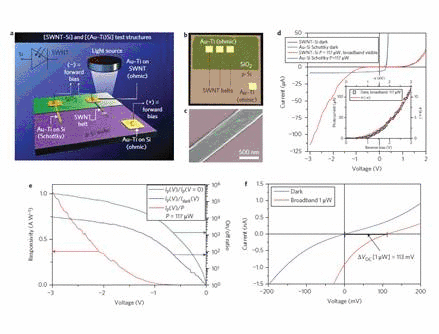
Recent progress in silicon photonics has dramatically advanced the
possible realization of heterogeneous logic circuits. A variety of
Boolean optoelectronic circuits have been proposed5. In this context,
experimental investigation of logic operations with both optical and
electrical inputs in chip-integrable devices is highly desirable.
Here, we present a new kind of photodiode-based logic device using
scalable heterojunctions of carbon nanotubes and silicon, the output
currents of which can be manipulated completely by both optical and
electrical inputs. This provides a novel platform for heterogeneous
optoelectronic logic elements with voltage-switchable photocurrent
responsivity of > 1 AW-1, photovoltage responsivity
of >1×105 VW-1, electrical on/off ratios
of >1×105 and optical on/off ratios of >1×104.
To demonstrate their scalability, we fabricated a large array of
photoactive elements on a centimetre-scalewafer. We also present
bidirectional phototransistors and novel clock-triggerable logic
elements such as a mixed optoelectronic AND gate, a 2-bit
optoelectronic ADDER/OR gate and a 4-bit optoelectronic
digital-to-analog converter.
- Voltage-switchable photocurrents in single-wall carbon nanotube—silicon junctions for analogue and digital optoelectonics
Young Lae Kim, Hyun Young Jung, Sora Park, Bo Li, Fangze Liu, Ji Hao, Young-Kyun Kwon, Yung Joon Jung, and Swastik Kar, Nature Photon. 8 (3), 239-243 (2014).
link: download:
download: 


"Type-switchable" FETs based on CNTs and nanoparticles
We have reported the large-scale assembly of type-switchable field effect transistors (FETs) based on carbon nanotubes (CNTs) and nanoparticles (NPs). In this device, the charges stored in NPs adjacent to ambipolar CNT channels were adjusted to control the carrier type and density in the channels. We demonstrated the real-time reconfiguration of individual FET types and logic circuit functionality. Theoretical simulation of a model system was provided to explain this doping effect. This work takes advantage of the ambipolar properties of CNTs and opens up the possibility to build new types of devices with reconfigurable functionalities.
- Large-scale assembly of 'type-switchable' field effect transistors based on carbon nanotubes and nanoparticles
Sung Myung, Sungjong Woo, Jiwoon Im, Hyungwoo Lee, Yo-Sep Min, Young Kyun Kwon and Seunghun Hong, Nanotech. 21 (34), 345301 (2010).
link: download:
download: 


"Textured" network devices
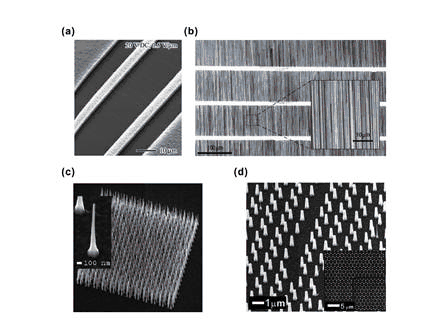
Based on the percolation theory, we have performed device simulations
on network devices. We have found that it is possible to make
semiconducting devices out of mixture of metallic and semiconducting
nanotubes.
- "Textured" Network Devices: Overcoming Fundamental Limitations of Nanotube/Nanowire Network-based Devices
Minbaek Lee, Meg Noah, June Park, Maeng-Je Seong, Young-Kyun Kwon, and Seunghun Hong, Small 5 (14), 1642-1648 (2009).
link: download:
download: 


- Nanowire and nanotube transistors for lab-on-a-chip applications
Minbaek Lee, Ku Youn Baik, Meg Noah, Young-Kyun Kwon, Jeong-O Lee, Seunghun Hong, Lab Chip 9 (16), 2267-2280 (2009).
link: download:
download: 

Linker-free directed assembly of high-performance integrated devices
dvanced electronic devices based on carbon nanotubes (NTs) and various types of nanowires (NWs) could have a role in next generation semiconductor architectures. However, the lack of a general fabrication method has held back the development of these devices for practical applications. Here we report an assembly strategy for devices based on NTs and NWs. Inert surface molecular patterns were used to direct the adsorption and alignment of NTs and NWs on bare surfaces to form device structures without the use of linker molecules. Substrate bias further enhanced the amount of NT and NW adsorption. Significantly, as all the processing steps can be performed with conventional microfabrication facilities, our method is readily accessible to the present semiconductor industry. We use this method to demonstrate large-scale assembly of NT- and NW-based integrated devices and their applications. We also provide extensive analysis regarding the reliability of the method.
- Linker-free directed assembly of high-performance integrated devices based on nanotubes and nanowires
M. Lee, J. Im, B.Y. Lee, S. Myung, J. Kang, L. Huang, Y.-K. Kwon, and S. Hong, Nature Nanotech. 1 (1), pp. 66-71 (2006).
link: download:
download: 


"Bucky-shuttle" memory device
We investigate the internal dynamics of a related model system, consisting of a K@C+60 endohedral complex enclosed in a C480 nanocapsule. We show this to be a tunable two-level system, where transitions between the two states can be induced by applying an electric field between the C480 end caps, and discuss its potential application as a nonvolatile memory element.
- "Bucky Shuttle" Memory Device: Synthetic Approach and Molecular Dynamics Simulations
Young-Kyun Kwon, David Tomanek, and Sumio Ijima, Phys. Rev. Lett. 82 (7), 1470-1473 (1999).
link: download:
download: 

- [Proceedings] The potential of carbon-based memory systems
Mark Brehob, Richard Enbody, Young-Kyun Kwon, and David Tomanek, in R. Rajsuman, and T. Wik (eds.), Memory Technology, Design and Testing, 1999. Records of the 1999 IEEE International Workshop on, pp. 110-114, IEEE Computer Society, San Jose, CA (1999).
link: download:
download: 

- [Patent] Nanocapsules Containing Charged Particles, their Uses and Methods of Forming the Same
David Tomanek, Richard J. Enbody, Young-Kyun Kwon and Mark Brehob, US Patent 6,473,351 issued on October 29, 2002.
link: download:
download: 

Chemical and Gas Adsorption on Nanostructures
Nanostructured materials, which ususally posses high surface/volume ratios, can be hosts of variouis adsorbates.
Aspirin on graphitic carbon structures
Using density functional theory, we investigate the adsorption properties of acetylsalicylic acid (aspirin) on the outer surfaces of a (10,0) carbon nanotube (CNT) and a (8,0) triazine-based graphitic carbon nitride nanotube (CNNT). The adsorption energies for the CNNT and CNT are 0.67 and 0.51 eV, respectively, and hence, the aspirin molecule binds more strongly to the CNNT. The stronger adsorption energy for the binding to the CNNT is ascribed to the high reactivity of its nitrogen atoms with high electron affinity. The CNNT exhibits local electric dipole moments that cause strong charge redistribution in the adsorbed aspirin molecule. The influence of an external electric field on the adsorption of aspirin on the nanotubes is explored by examining modifications in their electronic band structures, partial densities of states, and charge distributions. An electric field applied along a particular direction is found to induce molecular states of aspirin that lie within the in-gap region of the CNNT. This implies that the CNNT can be potentially utilized for the detection of aspirin.
Amino acids on graphitic carbon structures
Adsorption properties of Amino acids on graphitic carbon structures.
H2S detection in CNT-based devices
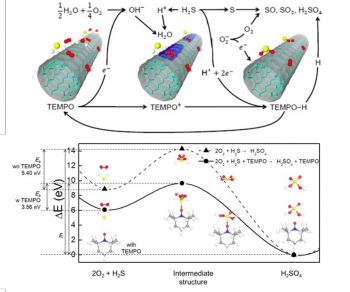 Here we report the highly effective detection of hydrogen sulfide
(H2S) gas by redox reactions based on single-walled carbon
nanotubes (SWCNTs) functionalized with
2,2,6,6-tetramethylpiperidine-1-oxyl (TEMPO) as a catalyst and we also
discuss the important role of water vapor in the electrical
conductivity of SWCNTs during the sensing of H2S molecules.
To explore the H2S sensing mechanism, we investigate the
adsorption properties of H2S on carbon nanotubes (CNTs) and
the effects of the TEMPO functionalization using first-principles
density functional theory (DFT) and we summarize currentchanges of
devices resulting from the redox reactions in the presence of
H2S. The semiconducting-SWCNT (s-SWCNT) device
functionalized with TEMPO shows a very high sensitivity of 420% at 60%
humidity, which is 17 times higher than a bare s-SWCNT device under
dry conditions. Our results offer promising prospects for personal
safety and real-time monitoring of H2S gases with the
highest sensitivity and low power consumption and potentially at a low
cost.
Here we report the highly effective detection of hydrogen sulfide
(H2S) gas by redox reactions based on single-walled carbon
nanotubes (SWCNTs) functionalized with
2,2,6,6-tetramethylpiperidine-1-oxyl (TEMPO) as a catalyst and we also
discuss the important role of water vapor in the electrical
conductivity of SWCNTs during the sensing of H2S molecules.
To explore the H2S sensing mechanism, we investigate the
adsorption properties of H2S on carbon nanotubes (CNTs) and
the effects of the TEMPO functionalization using first-principles
density functional theory (DFT) and we summarize currentchanges of
devices resulting from the redox reactions in the presence of
H2S. The semiconducting-SWCNT (s-SWCNT) device
functionalized with TEMPO shows a very high sensitivity of 420% at 60%
humidity, which is 17 times higher than a bare s-SWCNT device under
dry conditions. Our results offer promising prospects for personal
safety and real-time monitoring of H2S gases with the
highest sensitivity and low power consumption and potentially at a low
cost.
- High-performance H2S detection by redox reactions in semiconducting carbon nanotube-based devices
Hyun Young Jung, Young Lae Kim, Sora Park, Aniket A. Datar, Hyung-June Lee, Jun Huang, Sivasubramanian Somu, Ahmed Busnaina, Yung Joon Jung, and Young-Kyun Kwon, Analyst 138 (23), 7206-7211 (2013).
link: download:
download: 


Nicotine and caffeine on CNTs
Using first-principles calculations, we investigate the electronic structures and binding properties of nicotine and caffeine adsorbed on single-walled carbon nanotubes to determine whether CNTs are appropriate for filtering or sensing nicotine and caffeine molecules. We find that caffeine adsorbs more strongly than nicotine. The different binding characteristics are discussed by analyzing the modification of the electronic structure of the molecule-adsorbed CNTs. We also calculate the quantum conductance of the CNTs in the presence of nicotine or caffeine adsorbates and demonstrate that the influence of caffeine is stronger than nicotine on the conductance of the host CNT.
- Molecular adsorption study of nicotine and caffeine on single-walled carbon nanotubes from first principles
Hyung-June Lee, Gunn Kim, and Young-Kyun Kwon, Chem. Phys. Lett. 580, 57-61 (2013).
link: download:
download: 

Metal adsorbates on graphene
Metal atoms on graphene, when ionized, can act as a point-charge impurity to probe a charge response of graphene with the Dirac cone band structure. To understand the microscopic physics of the metal-atom-induced charge and spin polarization in graphene, we present scanning tunneling spectroscopy Metal adsorbates on graphene STS simulations based on density-functional theory calculations. We find that a Cs atom on graphene is fully ionized with a significant band-bending feature in the STS whereas the charge and magnetic states of Ba and La atoms on graphene appear to be complicated due to orbital hybridization and Coulomb interaction. By applying external electric field, we observe changes in charge donations and spin magnetic moments of the metal adsorbates on graphene.
- Tunable charge donation and spin polarization of metal adsorbates on graphene using an applied electric field
Jae-Hyeon Parq, Jaejun Yu, Young-Kyun Kwon, and Gunn Kim, Phys. Rev. B 82 (19), 193406 (2010).
link: download:
download: 

Glycines on CNTs for alcohol sensing
Glycines are spontaneously adsorbed to form into self-assembled nanoclutsers on single-walled carbon nanotubes (SWNTs). After formation of glycine nanoclusters on SWNTs, the field effect transistor (FET) devices show selective sensing ability to alcohols, such as isopropyl alcohol (IPA), methanol, and ethanol. Upon the adsorption of alcohol, the glycine-coated SWNT-FET devices exhibit pseudo-metallic transport behaviors, whereas the original and glycine-coated devices display conventional p-type transport characteristics. Computational studies support that the gate field screening effect induced by instantly formed glycine-alcohol pair layers seems to be responsible for the pseudo-metallic transport behavior.
- Self-clusterized Glycines on Single Walled Carbon Nanotubes for Alcohol Sensing
Hyun Jae Song, Yoonmi Lee, Tao Jiang, Adil-Gerai Kussow, Minbaek Lee, Seunghun Hong, Young-Kyun Kwon, and Hee Cheul Choi, J. Phys. Chem. C 112 (2), 629-634 (2008).
link: download:
download: 

Li Ion Batteries
A Li ion battery is one of rechargeable battery types, where Li ions move from the negative to the positive electrondes. blah blah
Li adsorption on transition metal dichalcogenides
Using ab initio density functional theory, we have investigated the adsorption properties of Li on WS2.
Li adsorption on schwarzite
Using ab initio density functional theory, we have investigated the adsorption properties of Li on schwarzites.
Hydrogen Storages
hydrogen storage is one of three main technologies to achieve so-called hydrogen economy in future. blah blah
H2 adsorption on metal-organic systems
Using ab initio density functional theory, we have investigated the adsorption properties of H2 on various organic systems
H2 adsorption on boron nitrides
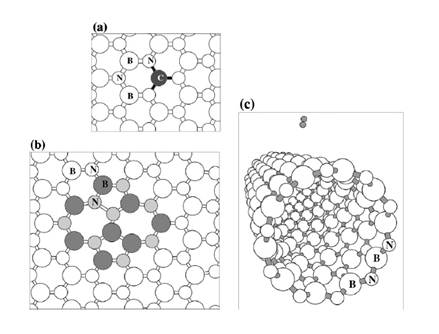
Using ab initio density functional theory, we have investigated
the adsorption properties of H2 on hexagonal boron
nitrides.
- Hydrogen adsorption on boron nitride nanotubes: A path to room-temperature hydrogen storage
Seung-Hoon Jhi, and Young-Kyun Kwon, Phys. Rev. B 69 (24), 245407 (2004).
link: download:
download: 

H2 adsorption on materials with "pocket" structures
Using ab initio density functional theory, we have investigated the adsorption properties of H2 on materials with “pocket” structures.
- Ethylene oxides as hydrogen storage material with pockets in the electronic binding energy distribution
Sungjong Woo and Young-Kyun Kwon, Phys. Rev. B 79 (7), 075404 (2009).
link: download:
download: 

H2 adsorption on carbon-based materials
Using ab initio density functional theory, we have investigated the adsorption properties of H2 on various carbon-based materials.
- Hydrogen Adsorption on sp2-Bonded Carbon Structures: Ab-initio Study
Young-Kyun Kwon, J. Kor. Phys. Soc. 57 (4), 778-786 (2010). (Highlight article)
link:
 download:
download: 

Carbon Nanotubes
Using ab initio density functional theory and semi-empirical theories, we have studied various properties and applications of carbon nanotubes (CNTs), which are seamless cylinders wrapped from graphene.
Equilibrium and electronic structures of singlewall CNTs
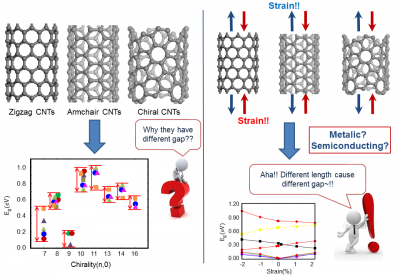 There are variety of different computational results on the same CNTs
with the same computational method. To resolve this issue, we swapped
completely the configurational spaces of each CNT considering its
structural symmetry determined by either as well as achiral (armchair
and zigzag) and chiral CNTs. As a result, We were able to identify the
most stable structure and the coupling effects between structural and
electronic properties.
There are variety of different computational results on the same CNTs
with the same computational method. To resolve this issue, we swapped
completely the configurational spaces of each CNT considering its
structural symmetry determined by either as well as achiral (armchair
and zigzag) and chiral CNTs. As a result, We were able to identify the
most stable structure and the coupling effects between structural and
electronic properties.
Orientational melting in CNT ropes
Using Monte Carlo simulations, we have investigated the possibility of an orientational melting transition within a “rope” of CNTs. hen twisting nanotubes bundle up during the synthesis, orientational dislocations or twistons arise from the competition between the anisotropic interbute interactions, which tend to align neighboring tubes, and the torsion rigidity that tends to keep individual tubes straight. We mapped the energetics of a rope containing twistons onto a alttice gas model and found that the onset of a free “diffusion” of twistons, conrresponding to orientational melting, occurs at TOM ≥ 160 K.
- Orientational Melting in Carbon Nanotube Ropes
Young-Kyun Kwon and David Tomanek, Phys. Rev. Lett. 84 (7), 1483-1486 (2000).
link: download:
download: 

Effect of intertube interaction in CNTs
We explored the effect of intertube interaction in bundles of single-wall CNTs and multiwall CNTs. Because of small intertube interaction and lattice frustration, we predicted very soft libration modes to occur and to disappear above the orientational melting temperature which marks the onset of free tube rotations about their axis. We also predicted such weak intertube coupling causes an additional electronic band dispersion of < 0.2 eV and opens up a pseudogap of the same magnitude at the Fermi level in the rope of (10,10) SWCNTs. In a (5,5)@(10,10) double wall CNT, the weak interwall interaction and the symmetry reduction causes four pseudogaps to open and close periodically near the Fermi level during the soft librational motaion. This electron-libration coupling, absent in solids composed of fullerenes and SWCNTs, may yield superconductivity in MWCNTs.
- Do Carbon Nanotubes Spin when Bundled ?
Young-Kyun Kwon, David Tomanek, Young Hee Lee, Kee Hag Lee, and Susumu Saito, J. Mater. Res. 13 (9), 2363-2367 (1998).
link: download:
download: 

- Effect of inter-tube coupling on the electronic structure of carbon nanotube ropes
Young-Kyun Kwon, Susumu Saito, and David Tomanek, Phys. Rev. B 58 (20), R13314-R13317 (1998).
link: download:
download: 

- Electronic and Structural Properties of Multi-Wall Carbon Nanotubes
Young-Kyun Kwon, and David Tomanek, Phys. Rev. B 58 (24), R16001-R16004 (1998).
link: download:
download: 

Microscopic growth mechansim of multi-wall CNTs
We investigated the morphology and structural stability at the growing edge of multi-wall CNTs using ab initio and parametrized calculations. We found that the open-ended structures are stabilized against dome closure by strong covalent bonds connecting the exposed edgs of adjacent walls. Growth at the open edge involves rearrangement of these bonds, which are mediated by carbon atoms bridging the gap and change the tip morphology significantly. Presence of a strong ``lip-lip'' interaction can explain formation of carbon nanotubes under annealing conditions.
- Morphology and Stability of Growing Multi-Wall Carbon Nanotubes
Young-Kyun Kwon, Young Hee Lee, Seong-Gon Kim, Philippe Jumd, David Tomanek, and Richard E. Smalley, Phys. Rev. Lett. 79 (11), 2065-2068 (1997).
link: download:
download: 

Other Carbon Materials
Following are other carbon materials we have investigated for their properties and applications.
T-carbon
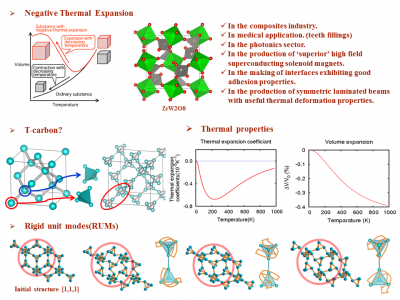 T-carbon proposed first in 2011 can be made from diamond, in which
every carbon atom is replaced with a carbon tetrahedron. We found that
T-carbon exhibits an unusual behavior, negative thermal expansion, for
which rigid unit modes excited in T-carbon are responsible.
T-carbon proposed first in 2011 can be made from diamond, in which
every carbon atom is replaced with a carbon tetrahedron. We found that
T-carbon exhibits an unusual behavior, negative thermal expansion, for
which rigid unit modes excited in T-carbon are responsible.
Micro-fastening system: nanovelcro
We have explored the suitability of nanotube-based hooks for bonding. Our results indicate that a large force of 3.0 nN is required to disengage two hooks, which are formed by the insertion of pentagon-heptaon pairs in a (7,0) CNT. Nanohooks based on various nanotubes are resilient and keep their structrual integrity during the opeing process. Arrays of hooks, which are permanetly anchored in solid surfaces, are a nanoscale counterpart of velcro fasteners, forming tough bonds with a capability of self-repair.
- Bonding and Energy Dissipation in a Nanohook Assembly
Savas Berber, Young-Kyun Kwon, and David Tomanek, Phys. Rev. Lett. 91 (16), 165503 (2003).
link: download:
download: 

This micro-fastening system was rigisterd as a US patent (US7,181,811).
- [Patent] Micro-Fastening System and Method of Manufacture
David Tomanek, Richard J. Enbody and Young-Kyun Kwon, US 7,181,811 issued on Feb 27, 2007.
link: download:
download: 

Microscopic formation mechanism of nanotube peapods
Using molecular dynamics calculations, we have investigated the absorption of a C60 molecule in a (10, 10) nanotube either through the open and or a large defect in the tube wall as possible scenarios for the hierarchical self-assembly of (C60)n@(10,10 “nano-peapods”. We found the absorption through a defect to be significantly more efficient than the end-on absorption. This process occurs most likely within a narrow launch velocity range for the fullerene that agrees well with the observed optimum temperature window for peapod formation.
- Microscopic Formation Mechanism of Nanotube Peapods
Savas Berber, Young-Kyun Kwon, and David Tomanek, Phys. Rev. Lett. 88 (18), 185502 (2002). (Cover Article)
link: download:
download: 

Carbon nanohorns
We have determined the stability, optimun geometry, and electronic properties of nanometer-sized capped graphitic cones, called “nanohorns”. Different nanohorn morphologies were considered, which differe in the relative location of the five terminating pentagons. Simulated scanning tunneling microscopy images of the various structures at different bias voltages reflect a net electron transfer towards the epntagon vertex sites. We found that the density of states at the tip, ovservable by scanning tunneling spectroscopy, can be used to discriminate between different tip structures.
- Electronic and structural properties of carbon nanohorns
Savas Berber, Young-Kyun Kwon, and David Tomanek, Phys. Rev. B 62 (4), R2291-R2294 (2000).
link: download:
download: 

Other Research
We are also performing our research on various interesting problems.
van der Waals epitaxy of ZnO on hBN
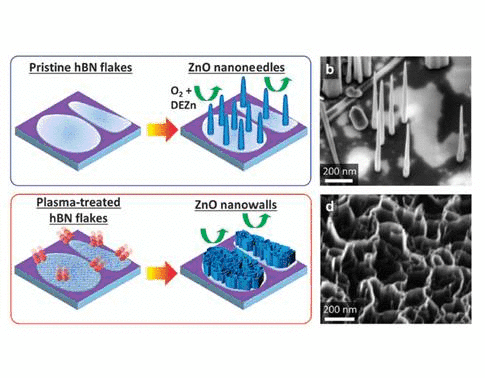
Integration of semiconductor on 2D atomic layers has offered flexible optoelectronic devices. Among various 2D atomic layers BN has great potentials for diverse device applications due to its excellent thermal conductivity and chemical stability as a wide-bandgap electric insulator. We found ZnO and BN were interacted through van der waals interaction using aberration-corrected high resolution transmission electron microscopy (HR-TEM) and ab initio calculations based on density function theory (DFT). We used DFT-D2 method of Grimme to describe London dispersion interactions.
- Architectured van der Waals epitaxy of ZnO nanostructures on hexagonal BN
Hongseok Oh, Young Joon Hong, Kun-Su Kim, Sangmoon Yoon, Hyeonjun Baek, Seoung-Hun Kang, Young-Kyun Kwon, Miyoung Kim, and Gyu-Chul Yi, NPG Asia Mater. 6, e145 (2014).
link:
 download:
download: 


LCO
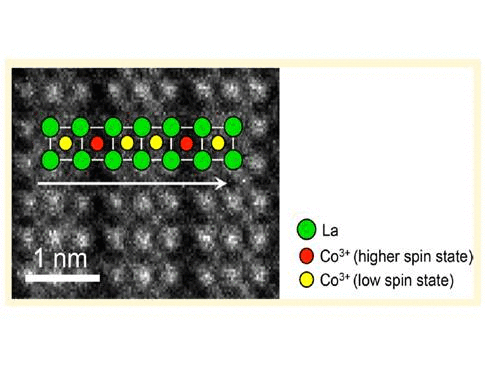
The nature of magnetic ordering in LaCoO3 epitaxial thin
films has been the subject of considerable debate. We present direct
observations of the spin-state modulation of Co ions in
LaCoO3 epitaxial thin films on an atomic scale using
aberration-corrected scanning transmission electron microscopy (STEM),
electron energy loss spectroscopy (EELS), and ab initio calculations
based on density functional theory (DFT) calculations. The results of
an atomic-resolution STEM/EELS study indicate that the superstructure
is not associated with oxygen vacancies; rather, it is associated with
a higher spin state of Co3+ ions and their
ordering. DFT calculations successfully reproduced the modulation of
lattice spacing with the introduction of spin ordering. This result
identifies the origins of intrinsic phenomena in strained
LaCoO3 and provides fundamental clues for understanding
ferromagnetism in Co-base oxides.
- Nanoscale Spin-State Ordering in LaCoO3 Epitaxial Thin Films
Ji-Hwan Kwon, Woo Seok Choi, Young-Kyun Kwon, Ranju Jung, Jian-Min Zuo, Ho Nyung Lee and Miyoung Kim, Chem. Mater. 26 (8), 2496-2501 (2014).
link: download:
download: 


Liquid metal nanodroplet dynamics inside nanocontainer
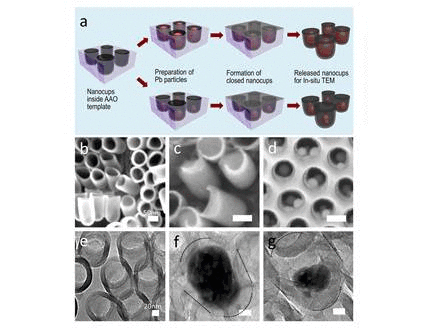
Here we report direct observations of spatial movements of
nanodroplets of Pb metal trapped inside sealed carbon nanocontainers.
We find drastic changes in the mobility of the liquid droplets as the
particle size increases from a few to a few ten nanometers. In open
containers the droplet becomes immobile and readily evaporates to the
vacuum environment. The particle mobility strongly depends on
confinement, particle size, and wetting on the enclosed surface. The
collisions between droplets increase mobility but the tendency is
reversed if collisions lead to droplet coalescence. The dynamics of
confined nanodroplets could provide new insights into the activity of
nanostructures in spatially constrained geometries.
Econophysics
The assessment of information transfer in the global economic network helps to understand the current environment and the outlook of an economy. Most approaches on global networks extract information transfer based mainly on a single variable. This paper establishes an entirely new bioinformatics-inspired approach to integrating information transfer derived from multiple variables and develops an international economic network accordingly. In the proposed methodology, we first construct the transfer entropies (TEs) between various intra- and inter-country pairs of economic time series variables, test their significances, and then use a weighted sum approach to aggregate information captured in each TE. Through a simulation study, the new method is shown to deliver better information integration compared to existing integration methods in that it can be applied even when intra-country variables are correlated. Empirical investigation with the real world data reveals that Western countries are more influential in the global economic network and that Japan has become less influential following the Asian currency crisis.
- Entropy-Based Analysis and Bioinformatics-Inspired Integration of Global Economic Information Transfer
Jinkyu Kim, Gunn Kim, Sungbae An, Young-Kyun Kwon, and Sungroh Yoon, PLoS One 8 (1), e51986 (2013).
link:
 download:
download: 



